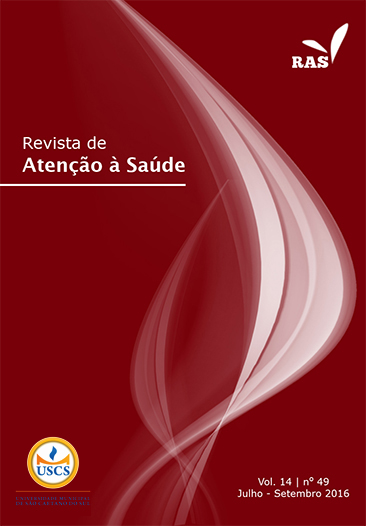Infections related to health care in adult intensive care units of adult hospitals: integrative review
DOI:
https://doi.org/10.13037/ras.vol14n49.3641Keywords:
university hospital, critical care unit, nosocomial infectionsAbstract
Introduction: Intensive Care Units (ICU) are places for the recovery of critically ill patients. However, high rates of infection are still prevalent in this area. Objective: To find in the literature studies characterizing the profile of health care associated infections (HAIs) in adult ICUs of university hospitals. Methodology: integrative literature review using the descriptors “university hospital/hospitais universitários”, “critical care unit/unidade de terapia intensiva”, and “nosocomial infections/infecção hospitalar” linked by the Boolean operator “AND” in the PUBMED database (US National Library of Medicine), LILACS (Latin American and Caribbean Health Sciences Literature) in the Virtual Health Library Research Portal, and Scientific Electronic Library Online (SciELO). Articles published between 2010 and 2015, available in full, in Portuguese, Spanish, and English were considered. Results: We found 397 articles, but after filters only four articles were included in this integrative review, 2 from the PUBMED database, 1 in LILACS, and 1 in SCIELO, performed in Cuba, Brazil, Colombia, and China. Most (n=3) of these were published in 2011. The proposed methodologies were prospective studies, quantitative, descriptive, and observational. Most studies (75%) were conducted by doctors, one of them a specialist epidemiologist. Conclusions: The main HAIs found in ICUs were ventilator associated pneumonia (VAP), followed by Bloodstream infection (BSI), and urinary tract infection (UTI). Knowing this profile can colaborate with staff and supervisory bodies training, reducing morbidity and mortality.
Downloads
References
Allegranzi B, Nejad SB, Combescure C, Graafmans W, Attar H, Donaldson L, et al. Burden of endemic health-care-associated infection in developing countries: systematic review and meta-analysis. The Lancet. 2011;377(9761):228-41.
Mayhall CG. Hospital epidemiology and infection control. Philadelphia: Lippincott Williams & Wilkins; 2012.
Agência Nacional de Vigilância Sanitária. Critérios diagnósticos de infecções relacionadas à assistência à saúde. Brasília: Agência Nacional de Vigilância Sanitária. 2013. (Agência Nacional de Vigilância Sanitária. Série Segurança do paciente e qualidade em serviços de saúde).
Neves C, Colet C. Perfil de uso de antimicrobianos e suas interações medicamentosas em uma UTI adulto do Rio Grande do Sul. Rev Epidemiol Control Infec. 2015;5(2):65-71.
Ercole FF, Franco LMC, Macieira TGR, Wenceslau LCC, Resende HIN, Chianca TCM. Risk of surgical site infection in patients undergoing orthopedic surgery. Rev Lat-Am Enfermagem. 2011;19(6):1362-8.
Romanzini AE, Jesus APM, Carvalho E, Sasaki VDM, Damiano VB, Gomes JJ. Orientações de enfermagem aos pacientes sobre o autocuidado e os sinais e sintomas de infecção de sítio cirúrgico para a pós-alta hospitalar de cirurgia cardíaca reconstrutora. Rev Min de Enferm. 2010;14(2):239-43.
Tabah A, Koulenti D, Laupland K, Misset B, Valles J, Carvalho FB, et al. Characteristics and determinants of outcome of hospital-acquired bloodstream infections in intensive care units: the EUROBACT International Cohort Study. Intensive Care Med. 2012;38(12):1930-45.
Rosado V, Romanelli RMC, Camargos PAM. Risk factors and preventive measures for catheter-related bloodstream infections. J Pediatr. 2011; 87(6):469-77.
Block SS. Disinfection, sterilization, and preservation. Philadelphia: Lippincott Williams & Wilkins; 2001.
Dal-Bó K, Silva RM, Sakae TM. Infecção hospitalar em uma unidade de terapia intensiva neonatal do sul do Brasil. Rev Bras Ter Intensiva 2012;24(4):381-5.
Umscheid CA, Mitchell MD, Doshi JA, Agarwal R, Williams K, Brennan PJ. Estimating the proportion of healthcare-associated infections that are reasonably preventable and the related mortality and costs. Infect Control Hosp Epidemiol. 2011;32(2):101-14.
Crossetti MGO. Revisão integrativa de pesquisa na enfermagem: o rigor cientifico que lhe é exigido. Rev Gaúcha Enferm. 2012;33(2):8-9.
Botelho LLR, Cunha CCA, Macedo M. O método da revisão integrativa nos estudos organizacionais. Gestão e Soc. 2011;5(11):121-36.
Souza MT, Silva MD, Carvalho R. Revisão integrativa: o que é e como fazer. Einstein (São Paulo). 2010;8:102-06.
Whittemore R, Knafl K. The integrative review: updated methodology. J Adv Nurs. 2005;52(5):546-53.
Baumann, R. O Brasil e os demais BRICs: comércio e política. Brasília: IPEA. 2010.
Wilson D, Purushothaman R. Dreaming with BRICs: the path to 2050. 99. ed. New York: Goldman, Sachs & Company; 2003.
Guanche-Garcell H, Requejo-Pino O, Rosenthal VD, Morales-Pérez C, Delgado-González O, Fernández-Gonzalez D. Device-associated infection rates in adult intensive care units of Cuban university hospitals: International Nosocomial Infection Control Consortium (INICC) findings. Int J Infect Diseases. 2011;15(5):357-62.
Oliveira AC, Kovner CT, Silva RS. Infecção hospitalar em unidade de tratamento intensivo de um hospital universitário brasileiro. Rev. Lat-Am Enfermagem. 2010;18(2):233-9.
Molina FJ, Díaz CA, Barrera L, De La Rosa G, Dennis R, Dueñas C, et al. Perfil microbiológico de la Infecciones en Unidades de Cuidados Intensivos de Colombia (EPISEPSIS Colombia). Med Intensiva. 2011;35(2):75-83.
Xie D-S, Lai R-P, Nie S-F. Surveys of catheter-associated urinary tract infection in a university hospital intensive care unit in China. Braz J Infect Dis. 2011;15(3):296-7.
Roriz-Filho JS, Vilar FC, Mota LM, Leal CL, Pisi PCB. Infecção do trato urinário. Medicina (Ribeirão Preto). 2010;43(2):118-25.
DiGiovine B, Chenoweth C, Watts C, Higgins M. The attributable mortality and costs of primary nosocomial bloodstream infections in the intensive care unit. Am J Respir Crit Care Med. 1999;160(3):976-81.
Warren JW. Catheter-associated urinary tract infections. Int J Antimicrob Agents. 2011;17(4):299-303.
Ferraz EM, Ferraz AA, Coelho HS, Viana VP, Sobral SM, Vasconcelos MD, et al. Postdischarge surveillance for nosocomial wound infection: does judicious monitoring find cases?. Am J Infect Control. 1995;23(5):290-4.
Giarola LB, Baratieri T, Costa AM, Bedendo J, Marcon SS, Waidman MAP. Infecção hospitalar na perspectiva dos profissionais de enfermagem: um estudo bibliográfico. Cogitare Enferm. 2012;17(1):151-7.
Downloads
Published
Issue
Section
License
Policy Proposal for Journals offering Free Delayed Access
Authors who publish in this magazine agree to the following terms:
- Authors maintain the copyright and grant the journal the right to the first publication, with the work simultaneously licensed under a Creative Commons Attribution License after publication, allowing the sharing of the work with recognition of the authorship of the work and initial publication in this journal.
- Authors are authorized to assume additional contracts separately, for non-exclusive distribution of the version of the work published in this magazine (eg, publishing in institutional repository or as a book chapter), with the acknowledgment of the authorship and initial publication in this journal.
- Authors are allowed and encouraged to publish and distribute their work online (eg in institutional repositories or on their personal page) at any point before or during the editorial process, as this can generate productive changes, as well as increase impact and citation of the published work (See The Effect of Open Access).









